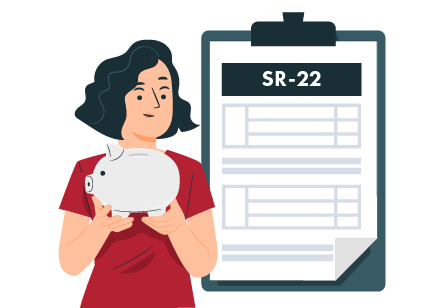Driving is a fundamental part of our daily lives. From work to running errands, we immediately rely on getting from Point A to Point B. But what happens if your license is suspended due to a violation? How do you get to school or work?
Getting a Hardship License may be the answer.
In this guide, we’ll explore a hardship license and the steps for obtaining a hardship license. You’ll be back driving on the road with your hardship or restricted license.
What is a Hardship License or Restricted License?
Most of us are highly dependent on the ability to drive. Losing your license may mean you can no longer get to school or work, having potentially devastating consequences on your life. What is a Hardship License?
A hardship license (sometimes called a restricted license, restricted driving permit, or a cinderella license) provides the driver with a legal right to continue driving to specified locations at designated times.
If you’ve lost your license due to a violation, don’t pinch pennies for Uber rides or sign up for a bus pass. You may be eligible to apply for a hardship or restricted license, depending on your situation. In this guide, we’ll help you understand what this type of license can do for you, how it works, and how to get one.
How Restricted Licenses Work
The intended purpose of a hardship or restricted license is to enable drivers with suspended licenses to continue to meet their adult obligations, namely, avoid losing their jobs or getting kicked out of school.
A restricted license does not restore your usual driving privileges. If granted, a hardship license or restricted license also has several restrictions placed on it.
A Hardship or restricted license typically includes restrictions on the following:
- The number of miles that can be driven
- The days of the week, you can drive
- The hours of the day you can drive
- Where you are allowed to drive to and from
- Specific routes you may or may not take when driving
What Can You Do With a Hardship License?
A Hardship License May Be Issued to Allow you To:
- Travel to and from work so you don’t lose your job
- Take or pick up your children from school
- Attend school/classes yourself (i.e. college)
- Attend drug and alcohol treatment or rehabilitation programs
- Drive to perform a court ordered program or community service
- Drive to get medical treatment or medical appointments
However, just because you need a hardship or restricted license for work, school, or other obligations doesn’t automatically mean you are eligible or entitled to this special license. You need to demonstrate that limited driving privileges will cause hardship in your everyday life.
Who Is Eligible for Hardship Licenses?
Eligibility to apply for a hardship or restricted license varies per state but is generally based on the following criteria:
- Your past driving records or violations
- Your license type
- The reason for your license suspension
- Whether or not this is your first suspension of your license
Commercial drivers aren’t usually granted hardship licenses, and those who have been involved in DUI accidents where significant damage and injuries were sustained, or a person who has been charged with more serious crimes such as a reckless driving violation, leaving the scene of an accident, or vehicular homicide may not qualify.
Hard Drivers License Suspensions
Some states or situations may also call for a hard suspension of your license first to be served for a designated suspension period before an individual becomes eligible to apply for a hardship license. In many cases, a hard suspension is set for one month and is common with DUI suspensions.
How Can I Get a Hardship Permit?
The law may vary slightly state by state, but we’ll walk you through the basics.
General Requirements for Applying for a Hardship or Restricted License: A Quick Overview
- Prove that you are not a danger to the public
- Attend a hearing before a public officer of the court
- Provide proof of medical evaluation and treatment
- Prove that hardship exists
- Prove that public transportation is not a viable option
- Pay a filing fee
Hardship License Application Process
This is the first step you’ll need to take to get your license. Regardless of your residence, the application is typically requested and completed through your state’s DMV. Once submitted, the issuance of a hardship license is not automatic. It may take time to process and validate that the driver is eligible. Failure to approve your request would result in significant hardship.
As part of the application process, the driver may be asked to provide proof of needing reasonable transportation, such as a class schedule for college, a doctor’s note confirming a medical necessity, or proof of employment. Additionally, it would be best to substantiate that public transportation is not a viable alternative for you and your family.
The driver will likely need to pay a ‘hardship license fee’ if approved. Those requesting a hardship or restricted license due to a DUI or DWI violation will likely, by law, need to pay for installing an ‘ignition interlock device’ (IID), requiring the driver to pass a built-in breathalyzer before starting and operating the vehicle.
Attend a Legal Hearing on Your Case
Once you have applied, the driver must typically attend a hearing in a court of law, during which you will demonstrate your eligibility for the license by submitting all required documentation and supporting evidence requested.
Formal hardship hearings are often requested by mail only and require a specific form provided by your state.
In some jurisdictions and cases, the hardship driver may be able to request an ‘informal hardship hearing’ on a walk-in basis during regular business hours.
Possible Outcomes of Your Hardship Hearing:
- Full reinstatement of your driver’s license
- Denial of license reinstatement
- Issuance of a Restricted driving permit or Hardship license
Driving with SR-22 Insurance
An SR-22 insurance policy was created to help at-risk individuals obtain the legal coverage necessary to drive in any state. Although not technically an insurance policy, an SR-22 form proves you meet state-mandated minimum insurance coverage needed to get back on the road.
Virtually all states mandate a minimum amount of coverage on your vehicle by law to legally operate it on a public roadway. However, suppose your license was suspended due to a DUI (for example). In that case, you may also risk losing your insurance. If your insurance company chooses to drop you, or you don’t have insurance, you still have options.
How Long Does it Take to Get a Restricted License?
Once the driver has passed any mandated ‘hard suspension’ periods, you can apply for a hardship or restricted license. After applying, you will be given a hearing date. Having an attorney to assist you in your defense might be wise. Once you have heard about it, it may take 10-90 days to get an answer as to the results.
Once you have the results of your hearing, it can take weeks to months to obtain a hardship license. Notification of approval is usually made by mail and may require further paperwork to be completed.
License Suspended? – don’t lose hope
Losing your license can feel overwhelming. You may have options if you’re overcome with worry about how to get to work, school, or even run essential errands. Applying for a Hardship License or restricted license may be the solution you need to get to and from those places that are essential.
Read more about these hardship licenses and other topics, such as What happens if you get caught driving without insurance.





